|
Mil Mi-24V Hind E
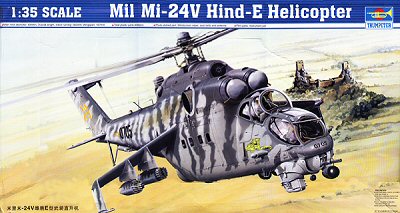
Trumpeter
S
u m m a r y
|
| Catalogue Number: |
TR05103 - Mi-24V Hind E |
| Scale: |
1/35 |
| Contents and Media: |
451 parts in light grey injection
moulded plastic; 18 in clear plastic; etched fret with 48 parts; large
decal sheet; two photo film panels |
| Price: |
USD$116.97
from Squadron.com |
| Review Type: |
FirstLook |
| Advantages: |
High quality mouldings with minimal
pin marks, big and impressive at 510mm long; numerous detail parts
including extensive ordnance, large decal sheet with stencil data for
aircraft and ordnance. |
| Disadvantages: |
|
| Recommendation: |
Recommended. |
Previewed
by Terry Ashley

Trumpeter's 1/35
scale Mi-24V Hind may be ordered online from Squadron.com
Following on from their excellent Mi-4
Hound comes this long awaited 1/35 kit of the big Mi-24 Hind and I can say
straight up, the wait was worth it.
The kit is big with the fuselage
measuring approx. 510mm from nose to tip of rear fin and represents a mid to
late production Mi-24V Hind E with features such as the AT-6 Missile Guidance
pod, the two RHAW sensors mounted on the forward fuselage sides and the
search/landing light on the Port side, the RHAW sensor mounted on the Gun
Camera faring and the top mounted IR Jammer as well as the mounting plates for
the engine exhausts IR suppressors although there are no suppressors in the
kit and an extensive suite of antenna and aerials for the Hind E.
The kit consists of 451 parts in light
grey plastic plus another 18 in clear plastic, an etched fret with 48 parts
and a large decal sheet plus two photo film panels for the main instrument
dials.
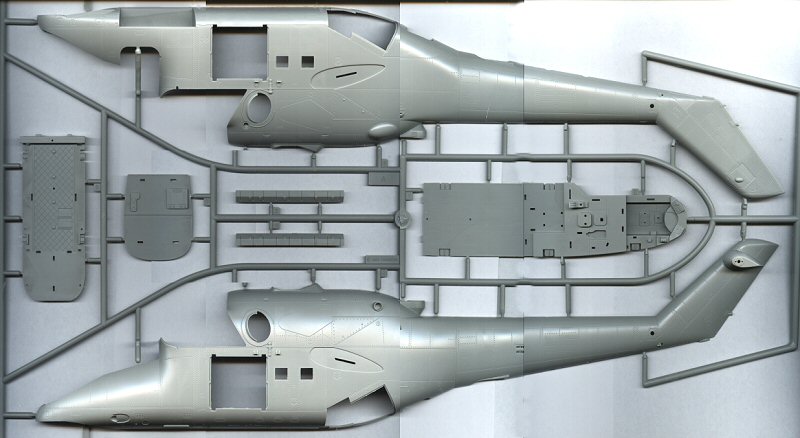
Click the
thumbnails below to view larger images:
The quality of the moulding is
excellent and highlights the marked improvement in Trumpeter kits over a very
short time period with finely engraved panel lines and bolt/rivet details but
the thing most apparent is the almost total lack of pin ejector marks on the
parts. Parts such as the Pilot’s door, main cabin doors and the separate clear
engine clamshell doors all have details on both sides but absolutely no pin
marks while the insides of the main undercarriage doors only have one shallow
pin park which is in a spot making its removal very easy, there are many other
finely moulded parts where the only cleanup needed is the usual mould seams.
The clear parts are quite thin and well formed but with one minor issue which
we’ll look at later and the etched parts add a degree of finesse and detail to
the kit.
The Cockpits/Cabin interior:
The two seats have separate cushions
with etched belt buckles while the belts can be made from any material such as
paper or tape.
 The
pilot’s instrument panel has the main panel as a clear part with fine raised
detail and holes to allow the photo film dials to show through, the large
starboard panel in treated in the same manner with clear front section and
photo film for the dials. The
pilot’s instrument panel has the main panel as a clear part with fine raised
detail and holes to allow the photo film dials to show through, the large
starboard panel in treated in the same manner with clear front section and
photo film for the dials.
The large cabin/cockpit floor has
various instrument panels and bulkheads attached which have nice engraved and
raised details along with well detailed control and cyclic sticks but no foot
rudder pedals. The distinctive cooling fan in front of the gunner has etched
fan blades for a nice scale look.
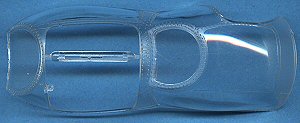 The
clear canopy is in one piece with separate pilot’s door with clear window and
separate gunner’s window/door both of which can be shown open and includes the
support braces and other details on the inside of the Pilot’s door such as the
grab handle and rear view mirror with etched support but there is no map case
or storage bag detail. The
clear canopy is in one piece with separate pilot’s door with clear window and
separate gunner’s window/door both of which can be shown open and includes the
support braces and other details on the inside of the Pilot’s door such as the
grab handle and rear view mirror with etched support but there is no map case
or storage bag detail.
The wiper blades are provided as
etched parts and the extended air data sensor boom has etched winglets on the
tip again for good detail definition. To achieve the correct contour of the
curved rear canopy section there is a mould seam line on the left side of the
canopy moulding and this will need to be sanded and the plastic polished
smooth, this is similar the central seam on the Tamiya F-14 and F15 and
Hasegawa F-16 cockpit canopies where there is a central seam line as a result
of the two part mould to get the correct contours.
The rear cabin has a separate rear
bulkhead with basic details and a roof/ceiling with nice details included and
there are the central crew seats, overall the cockpits/cabin have most of the
basics provided with scope for additional wiring and detail to enhance the
final appearance. Referring to the photos in the references listed below will
show there is a wealth of exposed wiring and other small fittings in the
cockpits that will keep the super detailer busy for some time.
The Engines:
The two TV3-117V engines have all the
basic structures including additional accessories and large sections of
plumbing and look quite good but again there is a wealth of additional wiring
and smaller plumbing that can be added by the super detailer. The three part
exhaust outlets have the outer section as a single piece so there is no join
seam to eliminate on the inside which is good.
 The
front Vortex dust/debris extractors are also three parts each that fit to a
front bulkhead with good detail definition on the parts, while the large
clamshell engine doors are included as clear parts. The
front Vortex dust/debris extractors are also three parts each that fit to a
front bulkhead with good detail definition on the parts, while the large
clamshell engine doors are included as clear parts.
These as mentioned have no pin marks
to be cleaned and have basic rib details on the insides but the real ribs are
more pronounced and could do with additional work if you want to show the door
open.
The small air intake on the top side
of the doors is actually moulded open which is an indication of the fine
moulding in the kit.
The central oil cooler intake with
de-icing system mounted above the engines is in two parts with good details
included.
Fuselage:
As mentioned the fuselage is huge and
moulded in the usual two halves and includes very finely engraved panel line
and rivet detail, the rivets are actually raised on the real machine but I
don’t think this will be overly noticeable on the final model as they are not
that visible when looking at picture of Hinds except in close up and can
always be accentuated by a dark wash.
There are also other raised details
where applicable such as the details above the cabin door and oil drain
outlets to the upper rear of cabin, these are again moulded open, while the
large APU exhaust on the port side has good detail with quite deep indentation
but could do with being drilled open completely.
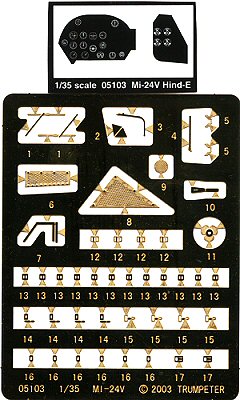 The small
intake above the port exhaust outlet has an etched screen to be added for good
detail definition and the intake screens on the rear tail section are also
provided as etched parts that fit into indentations provided on the fuselage
moulding. The small
intake above the port exhaust outlet has an etched screen to be added for good
detail definition and the intake screens on the rear tail section are also
provided as etched parts that fit into indentations provided on the fuselage
moulding.
The large fairing under the nose for
the missile guidance systems is a separate part which eliminates the central
seam line and sees the large FLIR/LLLTV missile optical guidance system in two
parts with good detail definition for the external door operating systems
although the protective doors are moulded closed.
The AT-6 missile guidance pod is in
three parts with the rounded nosecone a single piece again eliminating any
seam line cleanup. The pod has the small boarding step fairing included but
without the tread plate pattern but that is getting really picky and you will
need to add the small retaining rod from thin wire to finish off the pod and
there is also a separate centrally mounted flood light.
The two side mounted L-006 ‘Berjozka’
RHAW sensors are separate parts with good detail and you have to open up the
locating holes in the fuselage if you are going to include these on your
model, this also allows you to build an earlier model Hind E or Mi-35 without
the RHAW sensors if you wish? The fixed port side mounted search/landing light
is also as separate part for good detail definition as is the air conditioning
inlet mounted just behind the light fairing; this is in two parts for good
detail definition even though it is a very small part and goes to show the
level of detailing in the kit.
At the front is the USPU-24 four
barrelled rotating gun assembly and this consists of nicely detailed gun
barrels (the barrels need drilling) and mounting which are trapped between the
outer curved sides of the ‘turret’ which in turn is attached to the round base
plate, all this allows the guns to rotate and elevate when the assembly is
completed so you can pose the guns in any position.
The large cabin doors are in two
halves for each side with clear windows and mounting and retaining rods for
when shown open. The doors have details on both sides and again there are no
pin marks on the insides to deal with and under the rear fuselage is the small
inspection hatch and compartment with internal bulkheads and separate door
again minus pin marks on the inside ribbing details.
There are many other separate small
details and antenna provided to be added to the fuselage such as the Pilot
boarding step in etched metal and forward pitot tubes each side of the cockpit
and the ARK-15 loop antenna, DISS-15V antenna and UHF antenna on the
undersides of the rear fuselage and RHAW sensor on the fin trailing edge.
There are also the top mounted UHF/VHF communications antennas and rear strobe
light as well as the large ‘disco’ IR countermeasures device on the upper rear
fuselage with the IFF aerials front and rear being the blade type plus the
large tail bumper under the tail. All of these antenna and fittings are nicely
detailed and well within scale (except the IFF blades that could do with
thinning) and all this adds to the ‘busy’ external look typical of Russian
aircraft.
On the starboard front of the fuselage
is a separate slide out ammo loading box but this doesn’t have any ammo
included and looks a little bare, but the option is there to add your own ammo
belts if showing this open.
The rear all moving tailplanes are in
two halves each with nice surface details with both engraved and raised
details and are designed to be movable after assembly with an internal part
that lines up the two supporting pins on the tailplanes as you join the
fuselage halves.
When fitting the two fuselage halves
together you have to align the cockpit/engine assembly, the front gun turret,
the rear inspection compartment, the top rotor head mounting plate and the
internal fitting for the tailplanes, these shouldn’t be a problem as each have
well fitting and solid attachment points on the inside of the fuselage halves
but be sure not the glue the gun turret if you wish this to be movable after
assembly.
Undercarriage:
The twin nose wheel has the main leg,
the rear Y brace and retraction piston all with nice details plus the wheels
in two halves each and separate centre hub, the detail on the hub is a little
shallow but is there.
The nose gear door again has detail on
both sides with the smallest of pin marks to be cleanup up on the inside,
added to the door are the two support brackets between the door and main leg
as well as the small white ID light on the outside of the door for a very
complete assembly.
This assembly is fitted to its own
nose gear bay that is attached to the bottom of the cabin floor, the inside of
the bay is rather sparse and there is some plumbing that can be added to the
inside you wish.
The main undercarriage bays are in two
parts each which again could do with some additional plumbing. The main legs
are made up of three main parts each with the wheels in two halves with
separate hubs, the detail on the legs and shock absorbers is again quite nice
and all that is needed is the addition of the brake lines.
The wheel hubs have good detail but
you will have to add the small valve fittings.
The two undercarriage tubs are fitting
to the inside of the fuselage halves and the large mounting brackets should
provide for a solid attachment and there are additional separate fittings
added to the lower fuselage after the bays are attached to add additional
details.
The upper undercarriage doors have
nice external engraved details and internal detail with just a single pin mark
to be removed while the lower doors have the distinctive bulge with external
engraved details and internal detail again with very minor pin marks to be
removed and are very easy to deal with.
Stub Wings:
The two wings have upper and lower
halves that include the same fine engraved and raised details as the fuselage
with the upper parts including the integrated downward end pylon. The port
wing tip includes the gun camera fairing with RHAW sensor and has a separate
round end part for good definition.
The weapons pylons are in two parts
each and the pylon fairings on the wings have separate front sections for good
detail definition and about the only addition needed are the static
dischargers on the wing trailing edges.
For the outer fixed pylon there is a
choice of AT-2 or AT-6 launch rails depending of the type of missile you wish
to use?
The wings fit snugly to the fuselage
without any gaps to be filled and you should let the glue dry completely here
before attaching the pylons and ordnance.
Rotors:
The main rotor head has the central
section to which is added the five main blade roots with separate torque
linkages and pitch control levers attached to the lower control plate and top
hub cap. The detail on these parts is very good and effectively shows the
solid construction of these parts, the only additions needed are the large
electrical heating cables which are apparent on any images of the rotor heads.
The five blades themselves have raised
ribbing and bolt head details on the roots as well as fine engraved details on
the end plates and when assembled have a diameter of about 500mm, this kit
will need a large home after assembly.
The three blade tail rotor is in one
piece with separate central pitch control levers with nice raised and engraved
details and again there is some small plumbing to be added. The large tail
rotor housing of the correct shape is part of the port fuselage part and
includes the same engraved details.
Ordnance:
The kit offers a wide range of
ordnance covering just about every weapon the Hind E is qualified to carry
with the details and moulding being excellent with a mixture of raised and
engraved detail and is well up to the standard of the rest of the kit and not
looking like an afterthought as with some kits.
The list of ordnance in the kit is:
2 x FAB-50 Bombs
2 x FAB-100 Bombs
4 x FAB-250 Bombs
2 x FAB-500 Bombs
2 x OFAB-100 Bombs
2 x OFAB-250 Bombs
2 x ZAB-100 Bombs
2 x ZAB-500 Bombs
2 x KMGU-2 Cluster Bombs
4 x PTB-450 Fuel Tanks
2 x 9-A-669 Grenade Launcher (with
alternate barrels for a 9-A-624 triple Gun Pod)
2 x UPK-23 250 Twin Cannon Pod
4 x UB-32A-24 Rocket Pods
4 x B8V20 Rocket Pods
4 x 9M17P Falanga Anti-Tank Missiles
(AT-2 Swatter)
4 x 9M114 Sturm Anti-Tank Missiles
(AT-6 Spiral)
Some of the tail fins on the bombs
could do with some minor thinning for a better appearance and the AT-2s will
need the wiring added when fitted on their rails while the UB-32A-24 Rocket
Pods have the holes in the nose cone but there are no missiles included. The
instructions also have a chart showing the typical pylon loading positions for
the ordnance and the decal sheet includes stencil data for most of the
weapons.
Decals:
The large decal sheet has markings for
two aircraft as well as a good selection of stencil data for the airframe and
ordnance.
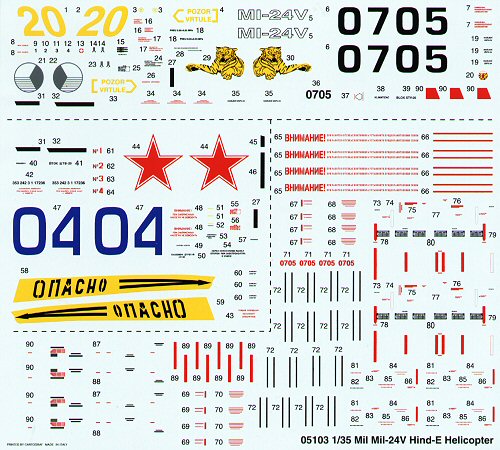
The decals are well printed with good
colour register and very thin carrier film cropped close to the printed item
and should react with decal setting solution well.
-
Aircraft 1. Mi-24V Hind E “Blue 04” CIS Army-ILA Berlin-Brandenburg 1992.
Finished in a Light Stone/Green cam scheme
-
Aircraft 2. Mi-24V “Tiger 0705” Czech Air Force Kleine Brogel(EBBL) Belgium,
August 1998.
Finished in Light Grey with Dark Grey tiger
stripes over the upper surfaces and sides.
The large colour painting guide has
five view drawings of the two aircraft showing the cam schemes and the decal
placement along with paint numbers given as FS numbers while the instruction
sheet has B&W drawings showing the decal placement on the ordnance.
This is an excellent kit and continues
the improvement in Trumpeter kits with very fine engraved details on the main
and smaller parts with raised detail where needed on other parts. All the
basic features of the mid to late Hind E are included but there is of course
scope for additional detailing and with a subject such as this there is plenty
of finer details in the cockpit/cabin and engines that will keep the super
detailer busy for a month or two.
About the only omissions might be the
earlier AT-2 guidance pod to go with the AT-2 missiles included in the kit or
the chaff/flare dispenser sometimes fitted under the rear fuselage on aircraft
of the type in the kit. There is also the later side mounted chaff/flare
dispensers and large IR suppressors on the engine exhausts but these are later
additions and not having these doesn’t diminish from the overall excellent
standard of the kit.
The choice of this particular version
of the Hind is a good one, for while the Mi-24V was predominately used by just
Russia and the former Warsaw Pact countries of Czechoslovakia, East Germany,
Hungary and Poland, the basic airframe configuration formed the basis for the
Mi-35 version exported to many countries in the Middle East and Africa with an
almost endless range of exotic cam schemes seen on these machines and with all
the aerials etc as separate parts it is easy to get the right fit for about
any version of the E.
Aftermarket resin makers such as Cobra
Company and Meteor Productions must be salivating at the opportunities this
kit provides, not only for additional internal details but the external parts
to make later versions as mentioned above, not to mention the decal
manufacturers.
Highly recommended for helicopter fans
and anyone who just wants a big impressive beast to get your teeth into.
Trumpeter is distributed
in Australia by J.B Wholesalers
http://www.jbwholesalers.com.au/
Text and Images Copyright © 2004 by
Terry Ashley
Page Created 09 February, 2004
Last updated 09 February, 2004
Back to HyperScale Main Page
Back to Reviews Page
|
Home | What's
New | Features
| Gallery |
Reviews | Reference
| Forum
| Search